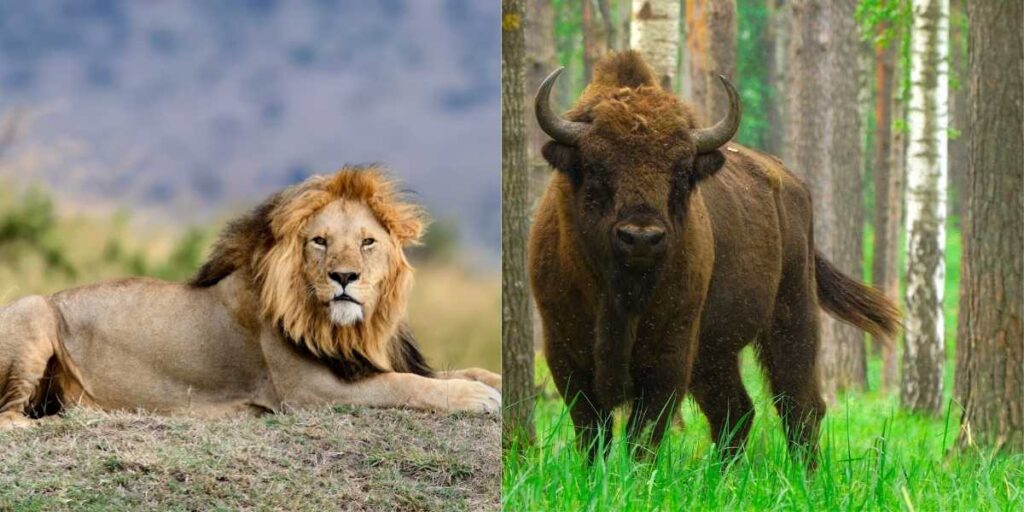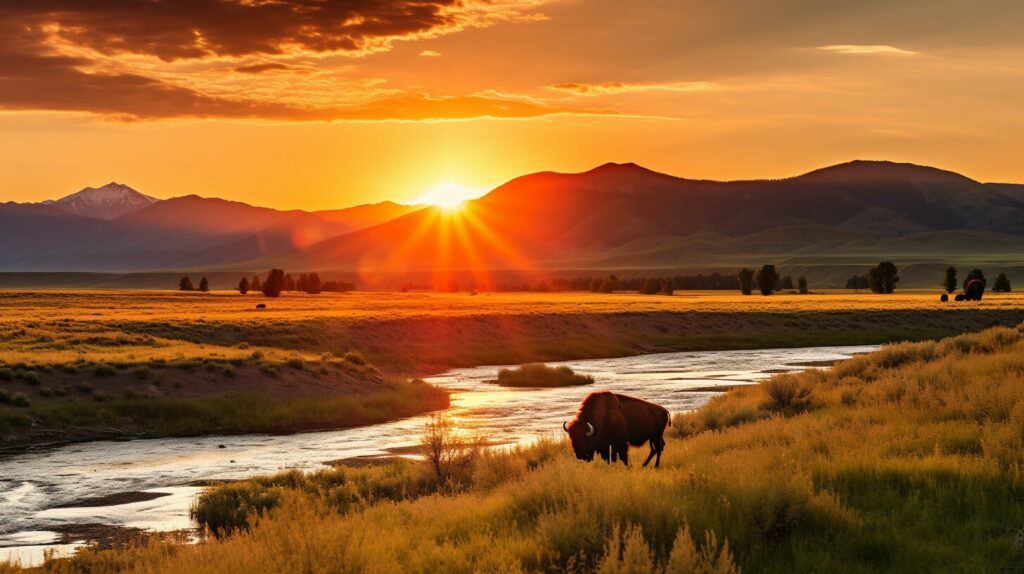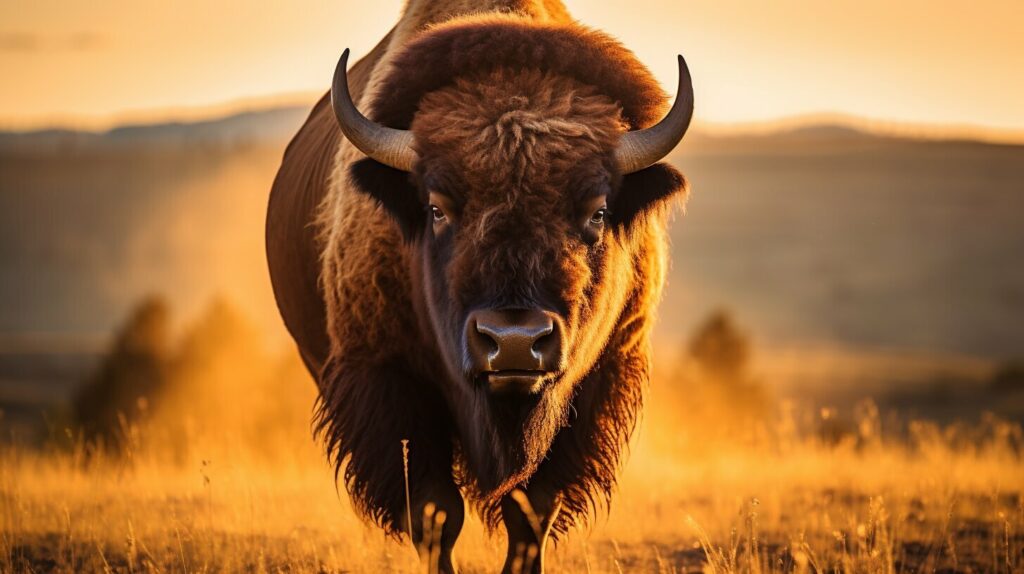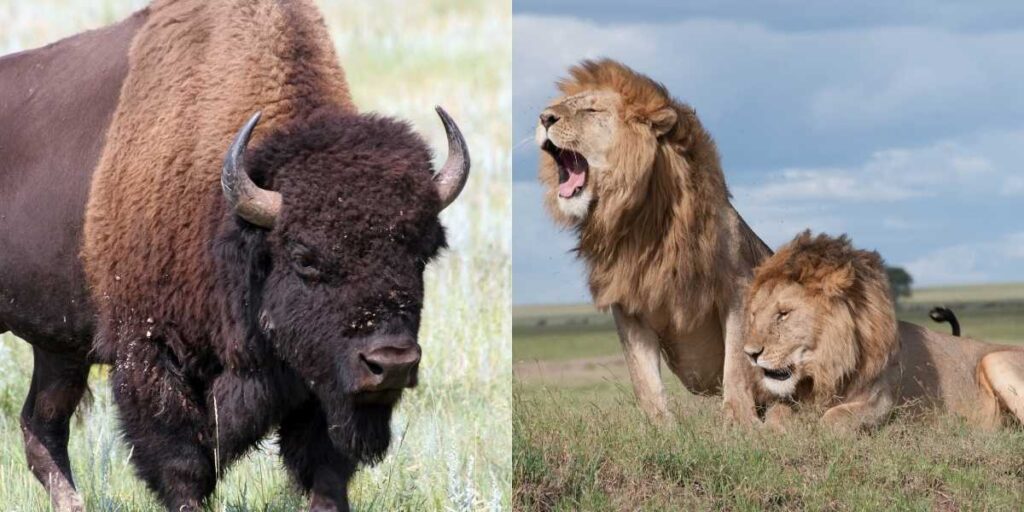The world of wildlife is filled with magnificent creatures, but few captivate our imagination like the bison and lion. In this article, we will delve into the intriguing comparison of these majestic beasts, exploring their characteristics and pondering the possibility of a bison versus lion encounter.
- Bison and lions are majestic beasts that have unique characteristics and behaviors.
- Lions are social animals that live in pride and primarily hunt medium- to large-sized prey.
- Bison were named the national mammal of the United States and have made a remarkable conservation comeback.
- Bison are the largest mammal in North America and live in herds on public lands.
- Both animals have fascinating traits that make them symbols of power and strength in their respective habitats.
The Size and Strength of Bison and Lions
When it comes to size and strength, both bison and lions are formidable creatures in their own right, each possessing unique characteristics that allow them to thrive in their habitats. Lions, known as the kings of the animal kingdom, are renowned for their powerful build and majestic presence. Adult male lions can weigh up to 420 pounds (190 kilograms) and measure about 8 feet (2.5 meters) in length, excluding their tails. Their muscular bodies, sharp claws, and strong jaws enable them to take down large prey and defend their territories.
Bisons, on the other hand, are the largest mammal in North America and can reach impressive sizes. Adult male bison, also known as bulls, can weigh up to 2,000 pounds (900 kilograms) and stand over 6 feet (1.8 meters) tall at the shoulder. They have massive heads, sturdy bodies, and formidable horns that can grow up to 2 feet (0.6 meters) long. These physical attributes make bison powerful and well-equipped to navigate their habitats and survive in harsh conditions.
While both bison and lions possess incredible strength, it is their size and unique adaptations that allow them to dominate their respective ecosystems. The lion’s muscular build and hunting prowess make it an efficient predator, while the bison’s robust physique and ability to withstand extreme temperatures ensure its survival in diverse environments. These majestic beasts exemplify the wonders of the animal kingdom and continue to captivate our imagination.

Habitat and Range: Where Bison and Lions Roam
The vast landscapes of our world provide the perfect backdrop for the distinct habitats of bison and lions, as they roam different regions in search of food, shelter, and safety. Let’s take a closer look at where these magnificent creatures call home.
Lions, known as the kings of the savannah, are primarily found in the grasslands, open woodlands, and scrub regions of Africa. The expansive African savannah is their preferred habitat, offering the perfect balance of prey and vegetation. From the formidable Serengeti plains to the majestic Maasai Mara, lions have adapted to thrive in these vast, open spaces. They can also be found in the dense forests of Gir National Park in India, where they have carved out their own niche.
Bison, on the other hand, roam the wide expanse of North America. These magnificent creatures are well-suited to different environments, from the grasslands and prairies to the mountainous regions of the United States and Canada. The Great Plains and Yellowstone National Park provide essential habitats for bison, where they can graze on the nutritious grasses and find shelter in the rolling hills. Their ability to survive in extreme weather conditions is a testament to their resilience and adaptability.
So, whether it’s the vast African savannah or the wide-open spaces of North America, bison and lions have found their place in the natural world. Their distinct habitats reflect their unique evolutionary paths and showcase the wonders of our diverse planet.
| Bison | Lions |
|---|---|
| Grasslands and prairies of North America | Grasslands, open woodlands, and scrub of Africa |
| Mountainous regions of the United States and Canada | Dense forests of Gir National Park, India |
| Great Plains and Yellowstone National Park | Serengeti plains and Maasai Mara |
Diet and Feeding Behaviors of Bison and Lions
The diet and feeding behaviors of bison and lions play a crucial role in shaping their lifestyles, influencing their daily routines, and impacting their overall survival. These majestic beasts exhibit distinct preferences when it comes to their food sources and hunting techniques.
Starting with bison, these magnificent creatures are herbivores, primarily relying on grasses as their main source of sustenance. They are well-adapted to grazing on the expansive prairies and meadows that make up their habitat. With their massive size and strong jaws, bison can consume large quantities of grass in a single day, allowing them to meet their energy requirements.
Lions, on the other hand, are carnivores and occupy the top of the food chain in their respective ecosystems. They primarily hunt medium- to large-sized prey, such as antelopes, zebras, and wildebeests. Lions use their exceptional strength and coordinated hunting strategies to bring down their quarry. Their social structure plays a crucial role in facilitating successful hunts, with lionesses often working together to surround and overpower their chosen target.
| Bison Diet | Lion Diet |
|---|---|
| Grasses | Medium- to large-sized prey (antelopes, zebras, wildebeests) |
“The diet and feeding behaviors of bison and lions play a crucial role in shaping their lifestyles, influencing their daily routines, and impacting their overall survival.”
The differing dietary patterns of bison and lions underscore their unique adaptations and ecological niches. While bison rely on plant-based sustenance to support their massive bodies, lions have evolved to be powerful hunters who can take down formidable prey. These contrasting feeding behaviors contribute to the overall balance and diversity of their respective ecosystems, highlighting the complex dynamics of nature and the remarkable strategies employed by these majestic beasts.
You May Like: Bison vs Bull

Both bison and lions exhibit fascinating social structures, with bison living in tight-knit herds and lions forming pride that symbolize strength and unity. In the wild, bison herds consist of females, their offspring, and a dominant male known as the herd bull. These herds can range in size from a few individuals to several hundred. The females within the herd have a hierarchical system based on age and experience, with older females occupying the higher ranks.
Lions, on the other hand, live in pride led by a dominant male, multiple lionesses, and their young. The lionesses form the backbone of the pride, working together to hunt, raise the cubs, and defend their territory. The pride structure is essential for their survival, as it allows them to coordinate their efforts and maximize their chances of success in hunting. The pride also provides protection and support for the young cubs, ensuring their survival in a harsh and competitive environment.
The dynamics within bison herds and lion pride are crucial for the overall well-being and success of the group. Cooperation, communication, and social hierarchy play significant roles in maintaining stability and ensuring the survival of these majestic beasts.
| Bison Herd Dynamics | Lion Pride Dynamics |
|---|---|
| Tight-knit herds with hierarchical structure | Close-knit prides with dominant male leadership |
| Females occupy higher ranks based on age and experience | Lionesses form the backbone of the pride |
| Herd bull protects the herd from potential threats | Dominant male defends the pride’s territory |
| Females coordinate efforts in raising offspring | Lionesses work together in hunting and rearing cubs |
The social structures and dynamics of bison herds and lion pride are truly fascinating to observe. The interplay between individuals within these groups highlights the importance of cooperation, communication, and leadership in maintaining a successful and harmonious environment.
Communication Methods: Roars and Signals
In the animal kingdom, effective communication is key, and both bison and lions have developed unique methods to convey messages and maintain social order. Lions, known as the kings of the savannah, utilize various forms of communication to coordinate their hunting strategies and establish dominance within their pride. They produce powerful roars that can be heard from miles away, serving as a vocal declaration of their presence and territorial boundaries. These majestic beasts also rely on scent markings, such as urine and feces, to communicate their reproductive status and mark their territories, ensuring their dominance is known to rival pride.
Bison, on the other hand, have evolved their own set of communication methods to thrive in the vast plains of North America. While not as vocally expressive as lions, these massive creatures utilize visual signals to communicate with their herd members. They engage in various behaviors, such as head shaking and horn thrashing, as a means of asserting dominance or warning others of potential danger. Moreover, bison rely heavily on olfactory cues, deploying their keen sense of smell to detect pheromones and other chemical signals that convey important information about the presence of predators or the availability of resources.
It is fascinating to observe how these two majestic beasts have adapted their communication methods to suit their environments and social structures. While lions rely on vocalizations and scent markings to maintain their pride and establish dominance, bison rely on visual displays and olfactory cues to navigate their herds and ensure the survival of their species.

As we delve deeper into the extraordinary world of bison and lions, it becomes clear that their communication methods are integral to their survival and success as a species. These unique traits and behaviors make them awe-inspiring creatures, capturing our imagination and reminding us of the wonders that exist within the animal kingdom.
Unique Traits: National Mammal and Conservation Success
Bison possess extraordinary traits that set them apart, such as their revered status as the national mammal of the United States and their remarkable journey of conservation triumph. These majestic creatures have captured the hearts of people around the world and have become a symbol of the American wilderness.
The designation of bison as the national mammal of the United States in 2016 was a testament to their cultural and historical significance. It recognized the important role that bison have played in the country’s history, serving as a vital resource for Native American tribes and early settlers. This recognition has helped to raise awareness about the importance of conserving and protecting these magnificent animals and their habitats.
Furthermore, bison have experienced a remarkable conservation success story. Once on the brink of extinction, their numbers dwindled to a few hundred individuals in the late 19th century. However, through dedicated conservation efforts, their populations have rebounded, and they now thrive in various protected areas across the country. This achievement stands as a testament to the power of conservation and the tireless efforts of conservationists, organizations, and governments.
Bison Conservation Table
| Year | Population | Conservation Milestone |
|---|---|---|
| 1902 | 23 | Bison Protection Established in Yellowstone National Park |
| 1956 | 2,000 | First Bison Transferred to Wind Cave National Park |
| 2001 | 10,000 | Bison Designated as a National Mammal of the United States |
| 2021 | Over 500,000 | Bison Population Thriving Across Various Protected Areas |
The conservation success of bison serves as a shining example of how concerted efforts and dedicated conservation programs can make a substantial difference in saving endangered species. It is a testament to our ability to restore and protect habitats, preserve biodiversity, and ensure the survival of these magnificent animals for future generations.
Conclusion
As we conclude our exploration of the Bison vs. lion battle, we are left in awe of these majestic creatures, each embodying power, and strength in their own unique ways.
Lions, the social kings of the savannah, live in pride consisting of several generations of lionesses, breeding males, and cubs. Their hunting prowess is legendary, as they primarily target medium- to large-sized prey, showcasing their incredible strength and agility. Lions communicate through mighty roars that can be heard for miles, as well as scent markings and visual signals that play a vital role in maintaining their social structure.
On the other hand, bison, named the national mammal of the United States, has experienced a remarkable conservation comeback. These mighty creatures are the largest mammals in North America and can be found roaming in vast herds on public lands. Bison primarily graze on grasses, utilizing their powerful jaws to consume substantial quantities. While they may have poor eyesight, their excellent senses of smell and hearing help them navigate their surroundings and detect potential threats.
Both bison and lions possess fascinating traits that make them true symbols of power and strength in their respective habitats. Whether it is the regal presence of a lion leading its pride or the massive herds of bison gracefully moving across the plains, these majestic beasts captivate our imagination and remind us of the incredible diversity and wonder of the animal kingdom.
FAQ
Q: What are the unique characteristics of bison and lions?
A: Bison are the largest mammal in North America and have made a remarkable conservation comeback. Lions, on the other hand, are social animals that live in pride and primarily hunt medium- to large-sized prey.
Q: Where can bison and lions be found?
A: Bison live in herds on public lands, while lions can be found in various habitats across Africa.
Q: What do bison and lions eat?
A: Bison primarily eat grasses, while lions hunt and consume a variety of prey.
Q: How do bison and lions communicate?
A: Bison and lions communicate through different methods including roars, scent markings, and visual signals.
Q: What are the social structures of bison and lions?
A: Bison live in herds and lions live in pride, both consisting of multiple individuals with specific roles within their groups.
Q: What are some unique traits of bison?
A: Bison have been named the national mammal of the United States and have achieved significant conservation success.



